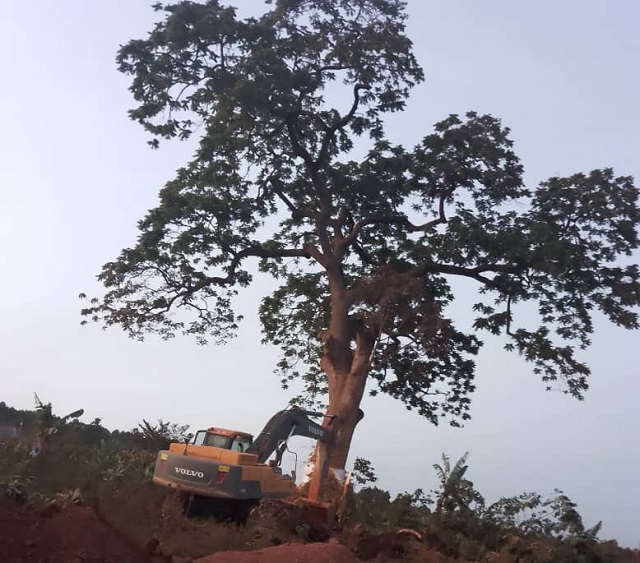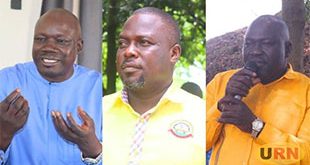
Kampala, Uganda | THE INDEPENDENT | There is divided opinion over the matter of compensating members of the Lugave clan in Buganda over a tree that was cut to pave way for the construction of Mpigi expressway.
The matter which has been silent since 2018 gained public attention following a court ruling on Thursday that allowed the Uganda National Roads Authority to compensate the clan members 4.66 million shillings instead of the desired 500 million shillings.
However, at the back of this court ruling, there is a story of bickering among members of one of the five oldest clans in Buganda, over the need for money and emotions attached to the cultural site whose existence has been long threatened.
Nabukalu the sacred tree
Like many traditional sites in Buganda and Africa at large, there is no written information about the scared tree but it is believed to be dating over 800 years according to oral history shared in the Lugave clan. Going by this assertion, traditionalists claim the tree is an ancestral home to spirits and a place of worship for generations.
Samuel Semakula Musoke, who is responsible for heritage and ancestral issues in the clan, shares that he first learnt about the tree in 1963 when his late father took him on a tour narrating the importance of the tree to their clan.
Recalling the legend surrounding this tree, many relators say its existence goes back to the founder of Lugave clan. It is said that the tree has for many generations been standing tall on a grave of one of the four daughters of Mukiibi Ssebuko called Nabukalu Nnabbuto.
Ssemakula adds that around 1961 to 1986, the clan faced a great challenge when the then clan head named Alexander Mpagi Katende started parceling out clan land to different people and before they knew it, the clan had lost almost all their ancestral land. The clan leaders dethroned the clan head and chased him but the damage made has impacted the clan for years.
Ssemakula says that to protect the scared tree, he reached out to the owner and convinced him to give them the 0.083 decimals around the tree as Kibanja holder a request which was granted. After giving them the land, the responsible clan leaders chose Hussein Katamba, as the caretaker of the site.
Disagreements on compensation
Godfrey Katende, deputy head (katikkiro) of the clan, notes that when Uganda National Roads Authority released designs for the proposed Mpigi-expressway, clan leaders opposed the move to cut down their scared tree advising the roads authority to reconsider their decision and come up with a fresh design for the road.
Katende says their request was rejected when the UNRA official explain that diverting the road at this specific session was impossible but insisted that the cultural site should be relocated. When the clan accepted relocating the site, the road valuer assessed and valued the Kibaja that host the site at 3.4 million shillings plus compensation of 100,000 shillings for the Muwafu tree.
The amount was arrived at based on the prevailing district rates for similar properties at the time of assessment. The valuer also included 1.075 million shilling as disturbance allowance thus pushing the total compensation rate to 4.66 million shillings.
Ssemakula states that when the price tag was placed on the cultural site, he rejected it and informed UNRA that they needed 500 million shillings if they are to relocate their ancestors to a new place.
In a letter he wrote to UNRA, Ssemakula asked for 140 million shillings which part of which could be used to buy a two-acre piece of land where the spirits could be relocated to and also aid construction of 6 special main houses for the spirits. He also budgeted for 160 million shillings as money needed to shift the spirits.
The two parties could later enter into negotiation to see how the issue could be amicably resolved. Before they could reach a settlement, the clan administrators led by Katende learnt of the matter and asked to join the negotiations.
Katende blames Ssemakula of having entered the first negotiations nearly as an individual neglecting the clan leadership and administrative structure. “In our negotiation, we requested UNRA to give the clan 150 million shillings to facilitate the relocation of our site. We also want development but we need some little money to buy a new piece of land and then perform rituals to relocate the spirits. This was the best solution and UNRA appeared to have agreed on this,” Katende noted.
In some countries which have developed in technology, such trees can be physically moved to a new area. However, in this case, rituals were to be formed to move the spirits before cutting down the scared tree.
Ssemakula says that when the clan administrators took over the negotiation, he withdrew from the entire process. He adds that as time went by, he learnt that the site caretaker had dragged UNRA to courts law.
In court, Katumba as an individual wanted UNRA to give him 500 million shillings but in his ruling, Judge Anthony Oyuko Ojok noted that the complaint failed to satisfy the court that the suit land has a cultural site on it. Justice Ojok further wondered why the cultural site that has existed for 800 years has never been gazetted and neither does it have permanent structures to prove its great importance to culture.
In his analysis, the judge noted that the site is not listed anywhere as required by the Historical Monument Act, with available evidence based on information Katamba received from communication from the spirits.
“…considering that he is only 42years, the evidence he adduced in support of this tree being a cultural site was hearsay since the event alleged to have taken place as said…in the 1800s,” the judge noted.
The selling of the clan land also came back to affect Katamba in the matter as the judge wondered how the tree and suit land could be the cultural site for the Lugave clan when it was owned for a long time by people outside the said clan.
“And it was evidence of the defendant that when compensation is being assessed it is done based on the features/properties on the land and not the unseen of the emotional and sentimental value of the same. The defendant is hereby allowed to pay the plaintiff the compensatory amount of UGX 4,661,800/= due to him over the suit land,” the judge ordered, adding that in case Katamba refused the money, UNRA could deposit it in court and proceed with road construction.
Before Katamba could file an appeal, UNRA put down the tree on Thursday evening. At this time, the frustrated Katamba had nothing more than curses to UNRA and future road users whom he warned about misfortunes. Away from the discussion of compensation.
Heritage and cultural assessment neglected
Elizabeth Kyazike, a renown cultural heritage specialist and archaeologist says many roads construction projects due to UNRA and other investors, fail to carry out heritage and cultural assessment which could guide on how to handle such issues.
Kyazike, who is also the dean of faculty of arts and social sciences at Kyambogo University, says that most projects focus on environment and social impact assessment reports which has seen the country lose much of its heritage, cultural and traditional aspects.
Not the first scared tree to be destroyed
Meanwhile, Nabukalu is not the first sacred tree to be lost by Lugave Clan. According to Ssemakula, there was another Mvule tree called Sseruku-lulengejja which was of high importance to the clan but it has since seized to exist.
The head of heritage and ancestral issues says that although this specific tree naturally fell down, its existence had already been threatened by born-again Christians who saw it as a satanic site given the different rituals that were being performed from it. Ssemakula adds that as the natural cycle is, the tree had sprouted again but the said Christians have been aggressively destroying every bud that could try to come out.
Tree worship is very common worldwide, certain trees were treated as another kind of sacred entity with all their metaphysical as well as physical manifestations.
In her study on tree spirituality, Rev. Lisa Ward claims that trees have a spirituality of their own. The trees, according to Rev Ward, are one of humanity’s most potent symbols. She adds that they are thought to represent the point of union of heaven, earth, and water, and is the personification of life in all of its domains.
In traditional beliefs both in Africa and other continents, the tree was thought to contain an abundance of heavenly creative force in most mythology and old religious images. Many such trees are known to a few people in contemporary times, yet priests and shamans see them as centers for traditional rituals such as sacrifices and the performance of different rituals.
*****
URN
 The Independent Uganda: You get the Truth we Pay the Price
The Independent Uganda: You get the Truth we Pay the Price




The .major issue was the preservation of the “Sacred Tree”
There was need to facilitate the transfer
As a lay person, when I ask you to enable the transfer of something valuable, I expect you to respect my wish. Was the period between the judgement and cutting the tree sufficient for the respective actity?
Oh compsation was 100,000/=
It was a special tree, as evidenced by the fact that an effort had been taken to retain control of the area where it stood.
I hope UNRA will meet the needs of those who valued the tree
Please look up a thesis investigating mental illness and traditional beliefs among some Ugandans: actually read at least two of them(2005-2010)
So there is a group of people who believed in the powers of the sacred tree
Have they suffered harm?
Wlll they suffer harm?
Does such harm spill over to the rest of society?
Just out of respect, I hope that you kept a picture of the living tree and the pieces of the felled tree for preservation and placement in a museum
Even those who looted what Africans valued during colonial times have returned the artefacts in their originL form
At a recent burial of a traditionL leader, , it was touching to hear that he preached ” love your culture but Lso respect the culture of others”
Looking at the trunk of the tree; was that tree ( even.if one assumed it was an.orfinary tree) worth the amount quoted (compesatiion)?
“In village speak”
The volume of wood, the likely products; even if converted into charcoal it would burn longer by virtue of its age.
Yes useful old trees burn long enough and sustain significant heat several hours after the flames have died out;
a measure applied to impact of an elder in the setting!
Hm, malice aforesought indeed
Malice aforethought
Malice afore”sought” intended from
the long period of absorbing varied shocks